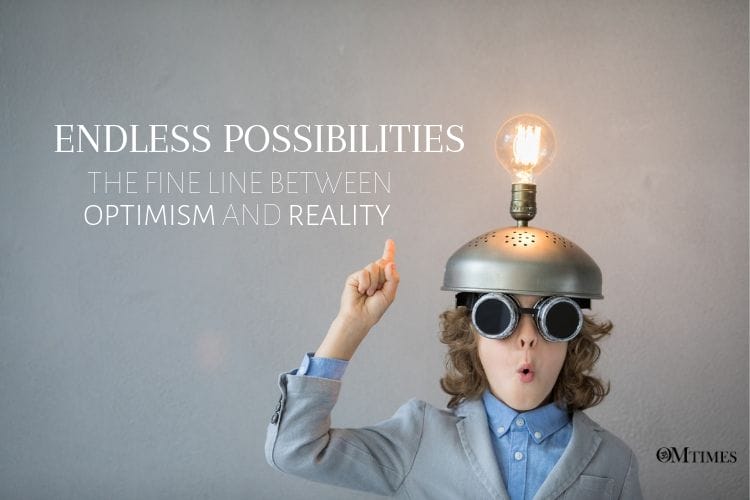Fine Line between Optimism and Reality

Fine Line Between Optimism and Reality
by Sanya Pirani
There’s something genuinely magical that happens when you combine children and dirt at a daycare. Children tend to be overly optimistic sometimes, not worried about the possibility that their garden might not grow, not thinking about the robin sitting in the nearby tree, waiting to peck the seed from the dirt. The daycare provider might be more pessimistic, realizing the risks associated with planting a garden. I am often the realist, but seeing the optimism of the children gives me optimism about the project. The reality is the garden experience will provide hours of fun and discipline for the children, and the potential to provide a learning experience for them to learn about healthy food and produce. Together both optimism and realism would achieve that.
To understand whether there is a fine line between optimism and reality, we have to look at what at some definitions. An optimist is someone who tends to see the brighter side of things, the possibilities that may exist. A pessimist, on the other hand, tends to have a more cautious, negative view of the world. A realist tries to see things as they are. A realist sees both the sides and reserves judgment based on objective analysis rather than emotional impulse.
If we take the common example of a glass filled halfway, to the optimist, there is water, and that’s what matters. To the pessimist, they see the empty part of the glass-seeing that there is not enough in the glass. All through this, the realist looks at the glass and sees that there is a glass filled with liquid to the halfway point. A realist doesn’t see if there is enough or not enough; the realist sees the present. What they see is that there is a glass. For the optimist to become the realist, she or he needs to understand the present, rather than seeing what will happen in the future. Same goes with the pessimist. The optimist and the pessimist are both futurists, disabling their ability to focus on what’s happening.
To explain this, we’ll take the example of a student taking a test. The optimist will say, “I’ll pass this test!” While the pessimist would say, “I am not sure if I will pass.” But for either of which would come true, they need to take the test. The realist sees that and will focus on taking the test, not fully going in depth on whether they’ll fail or pass, also focusing on the test itself. However, to pass the test, both optimism and realism are necessary. Without realism, society would be willing for things to happen, not taking action of the things needed to do to achieve the goal. Reality forces us to be aware of what’s needed to do. Awareness is what ties realism and optimism. Without awareness, we wouldn’t have any preparations for the future, with only optimism leading us on and taking the example of the weather. You can hope for the weather to be warm, even if the prediction is cold, but at least you have prepared for the cold just in case.
As said by H. C. Bailey, “For you to be a realist, you need to believe in miracles.” For me, this means realism helps us create change only if we believe that we can make a difference. I’ll never forget the first time when I first saw a young girl amid a war on YouTube. She was sitting on the ground with torn clothes, no shoes, and immense sadness and fear in her eyes. At first, I was sad, angry, and worried about her. But then, I realized I needed to do something to help children in need. My optimist mind did not allow me to stay sad, and my realist mind led me to action. Today, I have a non-profit that benefits others more than I could have dreamed of when I was seven. The only way my idea would have existed until now is because I understood optimism and reality are partners. Without optimism and reality, mankind wouldn’t have excelled to the point of which we have.
In the end, people are not simply optimists, pessimists, or realists. To survive and move forward, we need a combination of these factors. Martin Seligman, sums it up beautifully, “Optimism and pessimism operate on a continuum, of which the midpoint is realism” So in total, the optimist needs the pessimist just as much they need the realist. So yes, I believe because there is such a strong connection between the two, there is a fine line between optimism and reality, and we need both to survive.
Now, let me give you a question to ponder, are you an optimist or are you a realist or are you classified as both?
You will also enjoy Spiritual Values and The Bhagavad Gita
About the Author
 Sanya Pirani is the CEO/Founder of Sanya’s Hope For Children/CAP Agency Ambassador.
Sanya Pirani is the CEO/Founder of Sanya’s Hope For Children/CAP Agency Ambassador.
Email address: sanya@sanyashopeforchildren.org
Website page: (SHFC) https://www.sanyashopeforchildren.org/
“Helping a child means transforming a community one life at a time.”- Sanya Pirani
![]()
OMTimes Magazine is one of the leading on-line content providers of positivity, wellness and personal empowerment. OMTimes Magazine - Co-Creating a More Conscious Reality






